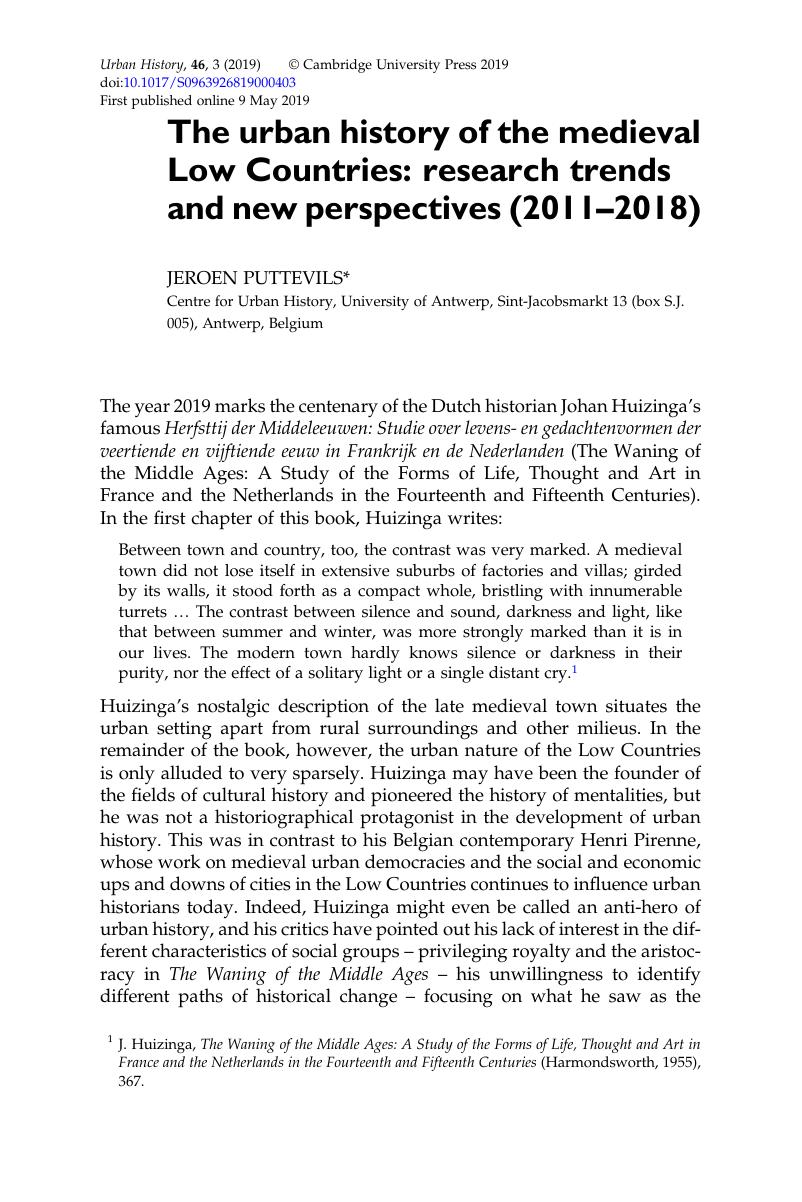No CrossRef data available.
Published online by Cambridge University Press: 09 May 2019

1 Huizinga, J., The Waning of the Middle Ages: A Study of the Forms of Life, Thought and Art in France and the Netherlands in the Fourteenth and Fifteenth Centuries (Harmondsworth, 1955), 367Google Scholar.
2 Boone, M., ‘“L'automne du Moyen Âge”: Johan Huizinga et Henri Pirenne ou “plusieurs vérités pour la même chose”’, in Moreno, P. and Palumbo, G. (eds.), L'automne du Moyen Âge. Textes, iconographie, philologie. Journées pour Alberto Varvaro (chaire Francqui au titre étranger 2003–2004) (Geneva, 2005), 27–51Google Scholar; Peters, E. and Simons, W.P., ‘The new Huizinga and the old Middle Ages’, Speculum, 74 (1999), 587–620CrossRefGoogle Scholar.
3 Haemers, J., ‘Urban history of the medieval Low Countries. Research trends and new perspectives (2000–2010)’, Urban History, 38 (2011), 345–54CrossRefGoogle Scholar. Recent monographs and articles which were published since 2011 and that are indicative of the trends seen in the theses are included in the footnotes (they are not extensively discussed in the text). The recent publication of two syntheses (in English) on the medieval history of the urban Low Countries is strong proof that this is a lively field: Blondé, B., Boone, M. and Bruaene, A.-L. Van (eds.), City and Society in the Low Countries, 1100–1600 (Cambridge, 2018)CrossRefGoogle Scholar; Lambert, V. and Stabel, P. (eds.), Golden Times: Wealth and Status in the Middle Ages in the Southern Low Countries (Tielt, 2016)Google Scholar.
4 Blondé, B. and Ryckbosch, W., ‘In “splendid isolation”. A comparative perspective on the historiographies of the “material renaissance” and the “consumer revolution”’, History of Retailing and Consumption, 1 (2015), 105–24CrossRefGoogle Scholar; Howell, M., Commerce before Capitalism in Europe, 1300–1600 (Cambridge, 2010)Google Scholar.
5 Burckhardt, J., The Civilization of the Renaissance in Italy, trans. Middlemore, S.G.C. (London, 1878)Google Scholar; Goldthwaite, R.A., Wealth and the Demand for Art in Italy, 1300–1600 (Baltimore, 1993)Google Scholar.
6 de Vries, J., The Industrious Revolution: Consumer Behaviour and the Household Economy, 1650 to the Present (Cambridge, 2008)CrossRefGoogle Scholar.
7 I. Sturtewagen, ‘All together respectably dressed: fashion and clothing in Bruges during the fifteenth and sixteenth centuries’, University of Antwerp Ph.D. thesis, 2016; I. Baatsen, ‘A bittersweet symphony: the social recipe of dining culture in late medieval and early modern Bruges (1438–1600)’, University of Antwerp Ph.D. thesis, 2016; J. De Groot, ‘At home in Renaissance Bruges: material and domestic culture in a city in decline, 1438–1600’, University of Antwerp Ph.D. thesis, 2017.
8 Brown, A. and Dumolyn, J. (eds.), Medieval Bruges, c. 850–1550 (Cambridge, 2018)CrossRefGoogle Scholar.
9 B. Verbist, ‘Traditie of innovatie? Wouter Ameyde, een makelaar in het laatmiddeleeuwse Brugge, 1498–1507’, University of Antwerp Ph.D. thesis, 2014; Pirenne, H., Les villes du Moyen Âge: essai d'histoire économique et sociale (Paris, 1927)Google Scholar, and the overview of the literature in Bolton, J.L. and Bruscoli, F. Guidi, ‘When did Antwerp replace Bruges as the commercial and financial centre of north-western Europe? The evidence of the Borromei ledger for 1438’, Economic History Review, 61 (2008), 360–79CrossRefGoogle Scholar.
10 Verbist, ‘Traditie of innovatie?’.
11 J. Trachet, ‘Inland outports: an interdisciplinary study of medieval harbour sites in the Zwin region’, University of Ghent Ph.D. thesis, 2016.
12 Blockmans, W., Metropolen aan de Noordzee: De Geschiedenis van Nederland, 1100–1560 (Amsterdam, 2010)Google Scholar; Gelderblom, O., Cities of Commerce: The Institutional Foundations of International Trade in the Low Countries, 1250–1650 (Princeton, 2013)Google Scholar; Puttevils, J., Merchants and Trading in the Sixteenth Century: The Golden Age of Antwerp (London, 2015)CrossRefGoogle Scholar.
13 A. Bardyn, ‘Women's fortunes: gender differences, property, and investment in late medieval Brabant’, KU Leuven Ph.D. thesis, 2018.
14 Stein, R., Magnanimous Dukes and Rising States: The Unification of the Burgundian Netherlands, 1380–1480 (Oxford, 2017)CrossRefGoogle Scholar.
15 R. Bosch, ‘Stedelijke macht tussen overvloed en stagnatie: Stadsfinanciën, staatsvorming en economie in het hertogdom Gelre, ca. 1350–1550’, University of Groningen Ph.D. thesis, 2018. See also van Schaik, R. (ed.), Economies, Public Finances, and the Impact of Institutional Changes in Interregional Perspective: The Low Countries and Neighbouring German Territories (14th–17th centuries) (Turnhout, 2015)CrossRefGoogle Scholar; Hanus, J., Tussen Stad en Eigen Gewin: Stadsfinanciën, Renteniers en Kredietmarkten in 's-Hertogenbosch (begin zestiende eeuw) (Amsterdam, 2007)Google Scholar.
16 B. Eersels, ‘The craft guilds are the city: political participation in late medieval towns, Brabant and Liège (c. 1360–1500)’, KU Leuven Ph.D. thesis, 2018. The duchy of Brabant also features in Vrancken, V., De Blijde Inkomsten van de Brabantse Hertogen: Macht, Opstand en Privileges in de Vijftiende Eeuw (Brussels, 2018)Google Scholar.
17 Lantschner, P., The Logic of Political Conflict in Medieval Cities: Italy and the Southern Low Countries, 1370–1440 (Oxford, 2015)CrossRefGoogle Scholar.
18 J. Coomans, ‘In pursuit of a healthy city: sanitation and the common good in the late medieval Low Countries’, University of Amsterdam Ph.D. thesis, 2018.
19 Related to memory is Matthew Champion's monograph on temporalities in the fifteenth-century Low Countries: Champion, M.S., The Fullness of Time: Temporalities of the Fifteenth-Century Low Countries (Chicago, 2017)CrossRefGoogle Scholar.
20 Corens, L., Peters, K. and Walsham, A. (eds.), ‘The social history of the archive: record-keeping in early modern Europe’, Past & Present Supplement, 230, 11 (2016)Google Scholar.
21 T. Van Gassen, ‘Het documentaire geheugen van een middeleeuwse grootstad: ontwikkeling en betekenis van de Gentse archieven’, University of Ghent Ph.D. thesis, 2017.
22 H. Franck, ‘Caritas et memoria: een studie naar de samenhang tussen armenzorg en memorieviering in de kosmopolitische stad Brugge tijdens de late middeleeuwen – vroegmoderne periode aan de hand van de organisatie en werking van de parochiale dissen’, KU Leuven Ph.D. thesis, 2018.
23 D. Faber, ‘Memoria in Leiden in de late middeleeuwen: stichten en bespreken; samenwerken en betwisten’, Utrecht University Ph.D. thesis, 2018.
24 A. Rijpma, ‘Funding public services through religious and charitable foundations in the late medieval Low Countries’, Utrecht University Ph.D. thesis, 2012.
25 Haemers, ‘Urban history of the medieval Low Countries’.
26 Birnbaum, D.J., Bonde, S. and Kestemont, M. (eds.), The Digital Middle Ages: A Speculum Supplement (Chicago, 2017)Google Scholar.